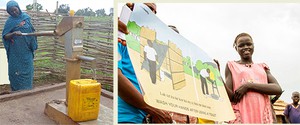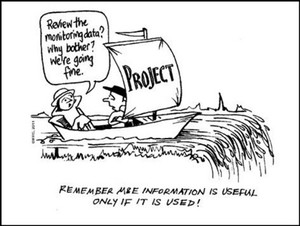Monitoring and evaluation (M&E), first introduced in Study Session 7, are critically important aspects of planning and management of any programme. Monitoring is the systematic and continuous assessment of the progress of a piece of work over time, in order to check that things are going to plan. Evaluation is an assessment of the value or worth of a project or programme and the extent to which the stated objectives have been achieved. Evaluation is not continuous and usually takes place periodically through the course of project/programme, or after completion. Together, monitoring and evaluation are a set of processes designed to measure the achievements and progress of a project or programme. The two terms are closely connected and are frequently combined, and therefore the abbreviation M&E is widely used.
What is M&E?
An effective M&E system measures the outputs, outcomes and impacts resulting from the implementation of a project or programme (see Box 13.1). To provide useful knowledge, these results need to be compared with the situation before the project/programme started, which requires baseline data. Baseline data gives information about the situation at the start of a project and provides a point of comparison against which future data, collected as part of a monitoring process, can be compared. Overall progress can be evaluated by comparing the two.
Monitoring requires regular and timely feedback in the form of reports from implementers to project managers so they can keep track of progress.
What two types of report are submitted upwards from implementers to managers in the OWNP?
Show answer
Implementers submit WASH reports of physical activities undertaken and financial reports.
These reports provide information about activities and what has been achieved in terms of outputs, and the financial reports give information on budgets and expenditure. Managers can use this information to assess progress and plan the next steps for their project.
Box 13.1 Outputs, outcomes and impacts
There are several words used in M&E that can be confused. They sound similar but have important differences in their meaning.
Outputs are the things produced by the project or programme. In WASH, examples include tangible products like new or rehabilitated wells and pumps, new water supply systems, new latrines and training manuals; they could be events and activities like running a training workshop for technicians, CLTSH promotion in a kebele, or producing hygiene promotion posters (Figure 13.2).

Figure 13.2 Outputs from WASH projects include (a) water points and (b) hygiene promotion materials.
Outcomes are the effects of the outputs, usually in the short- to medium-term. Examples following those above, could be the number of people who now have access to safe water as a result of the new water schemes, attendance at the training workshop or the number of communities that achieve ODF status.
Impacts are long-term effects and consequences. Examples could be a fall in the incidence of diarrhoeal disease, improved school attendance and pumps that last longer because they are well-maintained.
Why is M&E so essential?
A well-managed M&E system will:
- Track progress: M&E assesses inputs (expenditure), outputs and outcomes, which enables managers to track progress towards achieving specific objectives. For the OWNP, at national level this means progress towards meeting the UAP targets.
- Measure impact: M&E reduces guesswork and possible bias in reporting results by asking questions such as: What is the impact of the programme? Are the expected benefits being realised? Is health improving? Is school enrolment rising? Is the use of facilities and services increasing? Is community management expanding?
- Increase accountability: M&E can provide the basis for accountability if the information gathered is reported and shared with users and other stakeholders at all levels.
- Inform decision making: M&E provides evidence about the successes and failures of current and past projects that planners and managers need to make decisions about future projects. It should also encourage reflection on lessons learned in which managers ask themselves: What worked well in this project? What mistakes did we make? How can we do this better?
- Encourage investment: a good M&E system builds trust and confidence from government and donors which will increase possibilities of further investment.
- Build capacity:a good M&E system supports community participation and responsibility. It encourages the user communities to look regularly at how well their water schemes are working, what changes need to take place in hygiene and sanitation behaviours, what health benefits are resulting and what more needs to be done. It enables a community to build its own capacity, recognise its own successes and record them regularly.
Reporting on monitoring activity is essential, otherwise the information cannot be used. It is no use collecting data and then filing it away without sharing it (Figure 13.3). As noted above, one of the reasons for undertaking M&E is to inform decision makers and enable lessons to be learned–therefore they need to be provided with the information in a timely way for that benefit to happen.

Figure 13.3 Why M&E is important.
Who manages WASH M&E?
The WASH M&E system is managed by the coordination offices at national and regional levels and by WASH teams at woreda and kebele levels. Figure 13.4 shows the lines of communication. The two-directional arrows between the boxes indicate the links from woreda to national level are both upward in reporting to the higher levels and downwards as evaluation of the programme is incorporated in implementation.

Figure 13.4 Flow of WASH M&E information. (WIF, 2011)
WASH progress reports include information about physical activity and financial status and information about progress towards meeting planned targets and providing value for money. There are also regular review meetings at the various levels to consider the progress reports. These range from kebele WASH team meetings with all local WASH stakeholders to national level forums.
What are the two main WASH review meetings at national level?
Show answer
The Multi-Stakeholder Forum and Joint Technical Reviews. (You read about these in Study Session 11.)
What is monitored in WASH?
An enormous amount of information is gathered in the regular WASH monitoring process. The following includes only a selection of the types of data collected.
Water supply monitoring includes:
- location, number, type and current functionality status of water schemes/utilities both in rural and urban areas
- number and percentage of community users and the levels of service
- level of satisfaction of user communities
- quality of scheme/utility management and the level of financial sustainability
- level of accessibility to spares and repairs for operations and maintenance
- achievement of construction and rehabilitation targets.
Sanitation and hygiene monitoring includes:
- number of households with unimproved latrines or better
- number of households/people using a latrine – and number practising open defecation
- number of households/people with handwashing facilities near to a latrine
- number of households/people practising handwashing after defecation or handling children’s faeces.
Institutional WASH monitoring includes:
- types, functionality and use of drinking water sources either in or near school/institution compounds
- types, number and use of latrines and handwashing facilities in schools/institutions.
This data, together with the physical and financial WASH reports and household survey data is collected in the National WASH Inventory and related Management Information Systems, which are described in the next section.


